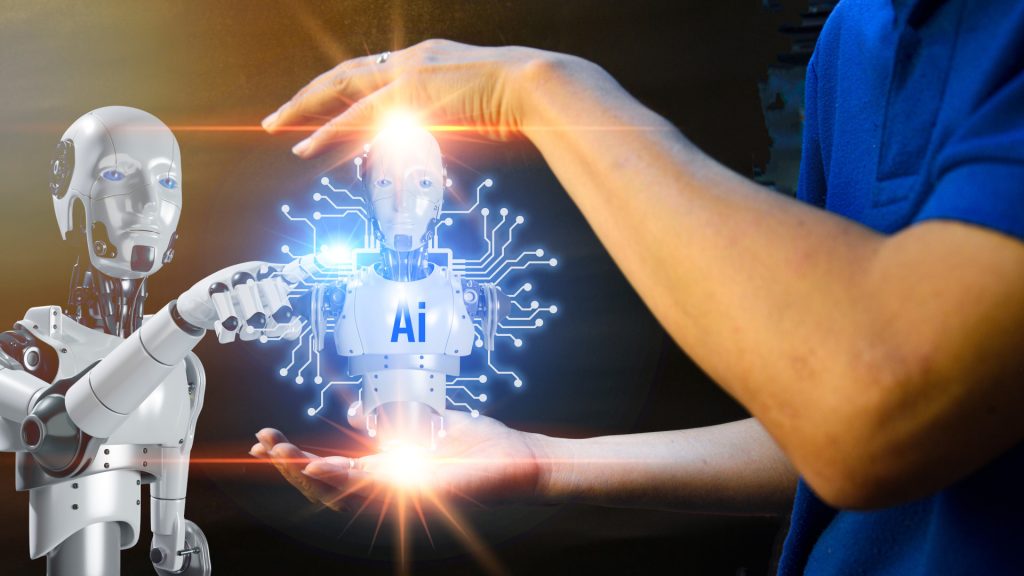Artificial intelligence (AI) has become an integral part of numerous industries, with its applications being diverse and constantly expanding. But where is AI used most or best?
AI is already having a major impact in many companies, particularly in areas such as the automotive industry, finance, healthcare and customer service. In the automotive industry, for example, AI systems are used for the development of autonomous vehicles based on the perception of the environment and decision-making. In finance, AI algorithms support the analysis of financial data, risk assessment and fraud prevention. In healthcare, AI systems help with diagnosis, personalized medicine and drug research. In customer service, AI-based chatbots and virtual assistants are used to process inquiries and improve customer satisfaction.
In order to keep up with global competition, it makes sense to integrate artificial intelligence (AI) into companies. The use of AI can offer numerous benefits, from automating repetitive tasks to analyzing large amounts of data to make informed decisions. By using AI technologies, companies can work more efficiently, reduce costs and develop innovative solutions. However, it is important that AI is used ethically and responsibly to minimize potential risks and consider the interests of all stakeholders.
What influence does the European Union’s AI Act have?
The adoption of the world’s first AI law by the EU Parliament is a significant step towards ensuring the use of artificial intelligence in accordance with fundamental ethical principles and human rights. Such a law will help create a clear legal framework to ensure that AI applications are used in a transparent, fair and ethically responsible manner.
The importance of such a law lies in the fact that it minimizes potential risks and abuses of AI technologies. It sets standards to ensure that AI systems do not discriminate, protect privacy and make decision-making transparent. In addition, such a law can strengthen consumer confidence and promote the acceptance of AI applications in society. The special thing about the AI Act is that it applies automatically and immediately in all EU countries as soon as it comes into force. Companies are therefore required to comply with the new guidelines and to check all AI applications used to ensure that they comply with the AI Act. In addition to the potential protection of people and the economy, the AI Act also entails a high level of bureaucracy.
Overall, the adoption of an AI law by the EU Parliament is by no means irrelevant. Rather, it is an important step to ensure that the development and use of AI technologies is in line with the fundamental values and rights of society.
Ethical issues
Does AI intervene ethically in our lives?
Risk management for responsible AI in companies
What role does data protection play in the use of AI systems?
Data protection and security are of crucial importance when using artificial intelligence (AI) and can be ensured by taking appropriate measures. These include:
- Privacy policies: Organizations should implement clear data protection policies and procedures to ensure that personal data is collected, stored and processed in accordance with applicable data protection laws.
- Data encryption: Encrypting data during transmission and storage can ensure that sensitive information is protected from unauthorized access.
- Anonymization: by anonymizing data, personal information can be removed before it is used in AI algorithms to protect user privacy.
- Security checks: Regular security reviews and audits should be conducted to identify and address potential security vulnerabilities.
- Transparent algorithms: The development of transparent and traceable AI algorithms makes it possible to explain decisions and results and ensure that they are fair and non-discriminatory.
- Training and awareness: employees should be regularly trained in data protection and security best practices to raise awareness of potential risks and ensure that appropriate measures are taken.
Although data privacy and security can be a challenge when using AI, they can be ensured through a combination of technological solutions, clear policies and training. It is important that companies and organizations take these aspects seriously and continuously update their security measures to keep up with evolving threats.
AI development worldwide
China is not only a major user of AI technologies, but also an important player in the development and implementation of AI solutions on a global scale.
In terms of outsourcing and dependency, there is a risk that the Western world will rely too heavily on Chinese companies in certain areas of AI technology. This could lead to a certain dependence on Chinese technologies and standards, which could entail strategic risks in the long term.
It is therefore important that Western countries increase their own investment in AI research and development while focusing on balanced cooperation with China based on mutual benefit and respect for privacy and security concerns. This could help to create a healthy competitive landscape and reduce dependence on individual regions.
Should we be afraid of AI?
The calls to stop AI often come from different sources and are based on different motives:
- Job loss: Some fear that AI technologies could destroy jobs, especially in industries that are highly automatable. This can lead to fears of social and economic disruption, resulting in calls to stop or limit the use of AI.
- Ethical concerns: There are concerns about ethical aspects of the use of AI, such as data protection, discrimination, privacy and the potential creation of autonomous weapon systems. These concerns may lead people to want to restrict or prohibit the use of AI to avoid potential negative effects.
- Control and power: In some cases, political or economic interests may be behind calls to restrict the use of AI. Individual actors may seek to control or monopolize the use of AI in order to strengthen their own power or competitive position.
Whether it is possible to stop AI is a complex question. Technological progress is often difficult to stop, especially when it offers potential economic benefits. However, governments, businesses and civil society can take action to regulate the use of AI and ensure that it is done in accordance with ethical and societal values. This could include, for example, introducing stricter data protection laws, developing ethical guidelines for AI or promoting education and retraining programs to deal with job losses. Ultimately, the future of AI depends on how we as a society deal with the challenges it presents and how we harness its potential for the benefit of all.
What are the benefits of using AI in companies?
Germany is facing a major new challenge: there is a shortage of skilled workers in almost all sectors. The baby boomer generation is gradually retiring, leaving a gap in the labor market. No groundbreaking solutions have yet been found. The hope of solving the problem of skilled workers through migration has not yet been realized.
AI can help to alleviate the shortage of skilled workers in certain industries by automating repetitive tasks and increasing efficiency. For example, AI-based systems can be used to optimize production and reduce the workload of skilled workers without compromising quality.
But how can a company practically optimize its processes with AI applications? What steps are necessary?
To start an AI project in a company, there are a few steps you can follow:
- Identify the need: Consider which processes in your business could be improved by using AI. This could be the automation of tasks, the prediction of demand or the optimization of resources.
- Research and planning: Familiarize yourself with the different AI technologies and applications that could be relevant to your project. Create a plan that outlines the goals, resources, timeline and potential challenges of the project.
- Data collection and preparation: AI models need data in order to learn and make predictions. Collect relevant data from your company and prepare it in such a way that it is suitable for analysis by AI algorithms.
- Choosing the right tools and platforms: There are a variety of tools and platforms for developing AI applications. Choose the ones that best suit the requirements of your project.
- Development and implementation: Develop the AI model or application according to your plan and implement it in your company. Ensure that you regularly monitor the performance of the model and adjust it if necessary.
- Training and integration: Train your employees to use the new AI technology and integrate it seamlessly into your workflows.
It is important to note that the success of an AI project depends on several factors, including a clear objective, adequate resources and support, and careful planning and implementation. If these steps are carried out carefully, an AI project can help to increase the efficiency and competitiveness of your business.
You can find detailed tips and recommendations in my new book “Business 5.0: Der Praxis Guide für Künstliche Intelligenz in Unternehmen: Opportunities and Risks”, written together with cyber security expert Thomas R. Köhler and published by CAMPUS Verlag in January 2024. We are a proven team: Business 5.0 is our second book together, after we published our book “Chefsache Metaverse” (also CAMPUS) in 2023.
In addition to our professional lives, AI is also making huge inroads into our everyday and private lives. The development of new technologies is exponential. It was only at the end of 2022 that generative artificial intelligence entered the public consciousness thanks to ChatGPT, a large language model developed by Open AI. Incredibly, just a year and a half later, almost every student can no longer imagine a learning process without various LLMs.
The demands on our education system are changing at lightning speed. What skills does a student still need to learn today? Is memorization a thing of the past?
The question of whether it is still important for students to memorize is a complex one that concerns the role of education and change in the modern world. However, it is clear that educational content and teaching methods need to adapt to changing demands and opportunities.
In today’s world, where information is readily available and technology plays an ever-increasing role, simply memorizing facts and formulas may no longer be enough. Instead, it is more important than ever that students learn how to find, evaluate and apply information, as well as think critically and solve problems.
However, this does not mean that memorization is outdated. There are still basic concepts and facts that are important and that students should master. However, the key lies in a balanced approach that combines memorization with the understanding and application of knowledge.
The curriculum may therefore need to be revised to place more emphasis on developing skills such as critical thinking, problem solving, collaboration and creative thinking. This could mean less time spent memorizing facts and more time spent applying and understanding these facts in different contexts.
Ultimately, the goal of the education system should be to prepare students for the demands of the modern world and give them the skills they need to be successful and productive, both in their personal lives and in their professional careers. Jack Ma, the founder of Alibaba, said back in 2017 that students in the future should mainly find music, art and sports in the curriculum. Things that promote human creativity in a special way.
Industry-specific applications
Automation of software development
Load optimization in logistics
Predictive policing for police/security services
Pastoral activities
Automated media content creation
Research and Development
Assortment optimization in fast fashion
....
would have to be distinguished from it:
AI as a production component (e.g. in cameras/cars)
Can AI revolutionize our health?
The integration of artificial intelligence (AI) into medicine undoubtedly has the potential to improve diagnosis and treatment processes and increase efficiency in the healthcare sector. AI systems can analyze large amounts of data and recognize patterns that may be difficult for human doctors to detect. As a result, they can assist with diagnosis, suggest treatment options and even predict the course of a disease.
However, AI does not replace doctors, but complements them. The human aspect of medicine, such as the ability to communicate empathetically with patients, the holistic understanding of individual needs and clinical experience, remains irreplaceable. Doctors can use AI systems to support and validate their decisions, but ultimately the responsibility for diagnosis and treatment decisions lies with the healthcare professional.
It is important to emphasize that AI systems are only as good as the data they have been trained with and that they may have certain limitations and uncertainties. In addition, ethical and legal aspects, such as data protection and liability, must be carefully considered.
Overall, the role of AI in medicine will continue to grow, but it will not replace human doctors for the time being. Rather, it will help to improve the quality of healthcare and provide doctors with valuable tools to make better decisions and optimize patient care.
AI and art: will we soon want to see AI art in museums?
Art has always been an artist’s expression of the world he or she has experienced and observed around them: a reflection of their time. Our time is now becoming increasingly digital in all areas of life and has recently also been shaped by artificial intelligence.
It therefore goes without saying that art is now finding its way into art. There are various scenarios as to how AI could find its place in art. What will actually happen in the end remains to be seen. A first possible scenario sees AI as a supporting tool for the artist. The artist uses AI as a working tool. In a second scenario, the artist and AI work hand in hand. Only in the third conceivable scenario does the AI take over and replace the artist. Will we then really be celebrating AI like a new Picasso?
The question of whether an artificial intelligence (AI) could ever become a new Picasso is complex and leads to discussions about the nature of creativity, originality and human experience.
AI systems can generate amazing works based on huge datasets of artworks and are able to mimic styles or explore new patterns. Some AI-generated artworks have already attracted recognition and interest.
However, creativity is not only the result of algorithms or data sets, but also the result of human emotion, experience and consciousness. Part of the fascination of art lies in the unique perspective and expression of the artist sharing their thoughts, feelings and interpretations of the world. This human dimension of art may be difficult to replicate by AI.
It is possible that AI systems can help to discover new forms of art or extend traditional methods. They could inspire and support artists by providing new tools and techniques. But ultimately, the question of whether an AI could become a new Picasso is likely to remain open to interpretation and ongoing debate about the nature of creativity and the role of technology in art.
Quo vadis AI?
The future of artificial intelligence (AI) continues to promise significant advances and profound changes in various areas. Some of the areas that are expected to be greatly impacted by AI technologies are:
- Healthcare: AI will play an increasingly important role in diagnosis, treatment planning and medical research. AI systems are expected to help develop personalized medicine and more precise treatments.
- Automotive industry: Self-driving vehicles are being further developed and could increasingly be seen on the roads in the coming years. AI will play a key role in the vehicle’s perception of its surroundings and decision-making.
- Finance: AI-based systems will continue to be used in the analysis of financial data to make trading decisions, assess risk and combat fraud.
- Education: AI can help to offer personalized learning content, track learning progress and support teachers in preparing lessons.
- Customer service: Chatbots and virtual assistants are increasingly being used to answer customer queries and improve customer service.
However, there are also areas in which human interaction and expertise will remain irreplaceable. These include, for example, creativity, interpersonal relationships, complex decision-making and moral judgment.
Overall, the journey of AI in the coming years will be characterized by continuous evolution, with new applications emerging and existing applications being further developed. It is important that these developments take place in a way that is ethically responsible and takes into account the interests of all stakeholders.







